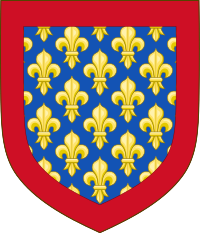
Back آل فالوا Arabic Valua sülaləsi Azerbaijani Валуа Byelorussian Валюа (дынастыя) BE-X-OLD Валоа (династия) Bulgarian Valois (dinastija) BS Dinastia Valois Catalan Valois Czech Валуа CV Huset Valois Danish
| House of Valois | |
|---|---|
 Arms of County of Valois | |
| Parent house | Capetian dynasty |
| Country |
|
| Founded | 1284 |
| Founder | Charles, Count of Valois |
| Final ruler | Henry III of France in France Marie de Nemours in Neuchâtel |
| Cadet branches |
|
| History of France |
|---|
 |
| Timeline |
| Topics |
|
|
The Capetian House of Valois[a] (UK: /ˈvælwɑː/ VAL-wah, also US: /vælˈwɑː, vɑːlˈwɑː/ va(h)l-WAH,[1] French: [valwa]) was a cadet branch of the Capetian dynasty. They succeeded the House of Capet (or "Direct Capetians") to the French throne, and were the royal house of France from 1328 to 1589. Junior members of the family founded cadet branches in Orléans, Anjou, Burgundy, and Alençon.
The Valois descended from Charles, Count of Valois (1270–1325), the second surviving son of King Philip III of France (reigned 1270–1285). Their title to the throne was based on a precedent in 1316 (later retroactively attributed to the Merovingian Salic law) which excluded females (Joan II of Navarre), as well as male descendants through the distaff side (Edward III of England), from the succession to the French throne.
After holding the throne for several centuries the Valois male line became extinct and the House of Bourbon succeeded the Valois to the throne as the senior surviving branch of the Capetian dynasty.
Cite error: There are <ref group=lower-alpha> tags or {{efn}} templates on this page, but the references will not show without a {{reflist|group=lower-alpha}} template or {{notelist}} template (see the help page).
- ^ Wells, John C. (2008). Longman Pronunciation Dictionary (3rd ed.). Longman. ISBN 978-1-4058-8118-0.; Jones, Daniel (2011). Roach, Peter; Setter, Jane; Esling, John (eds.). Cambridge English Pronouncing Dictionary (18th ed.). Cambridge University Press. ISBN 978-0-521-15255-6.